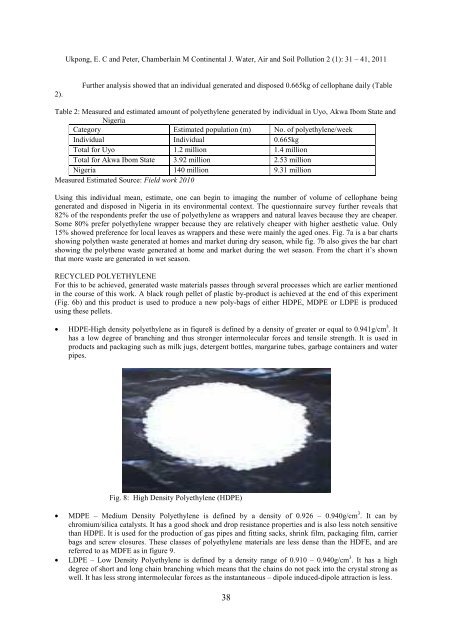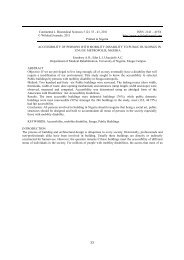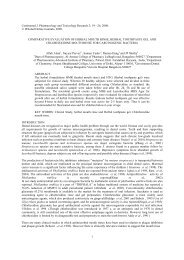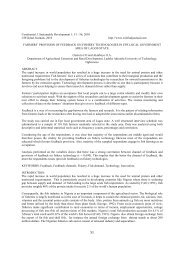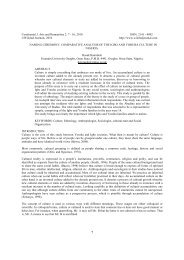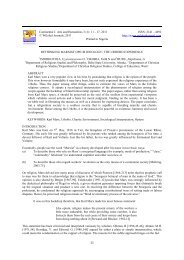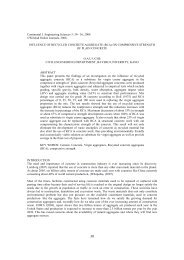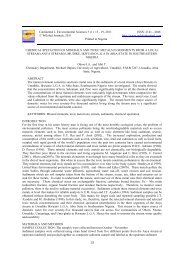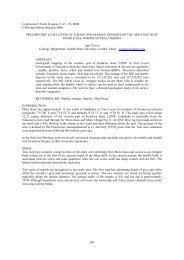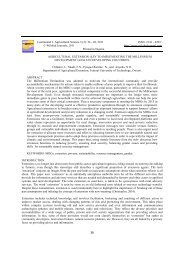Vol 2 _1_ - Cont. J Water, Air and Soil Pollution - Wilolud Journals
Vol 2 _1_ - Cont. J Water, Air and Soil Pollution - Wilolud Journals
Vol 2 _1_ - Cont. J Water, Air and Soil Pollution - Wilolud Journals
You also want an ePaper? Increase the reach of your titles
YUMPU automatically turns print PDFs into web optimized ePapers that Google loves.
Ukpong, E. C <strong>and</strong> Peter, Chamberlain M <strong>Cont</strong>inental J. <strong>Water</strong>, <strong>Air</strong> <strong>and</strong> <strong>Soil</strong> <strong>Pollution</strong> 2 (1): 31 – 41, 20112).Further analysis showed that an individual generated <strong>and</strong> disposed 0.665kg of cellophane daily (TableTable 2: Measured <strong>and</strong> estimated amount of polyethylene generated by individual in Uyo, Akwa Ibom State <strong>and</strong>NigeriaCategory Estimated population (m) No. of polyethylene/weekIndividual Individual 0.665kgTotal for Uyo 1.2 million 1.4 millionTotal for Akwa Ibom State 3.92 million 2.53 millionNigeria 140 million 9.31 millionMeasured Estimated Source: Field work 2010Using this individual mean, estimate, one can begin to imaging the number of volume of cellophane beinggenerated <strong>and</strong> disposed in Nigeria in its environmental context. The questionnaire survey further reveals that82% of the respondents prefer the use of polyethylene as wrappers <strong>and</strong> natural leaves because they are cheaper.Some 80% prefer polyethylene wrapper because they are relatively cheaper with higher aesthetic value. Only15% showed preference for local leaves as wrappers <strong>and</strong> these were mainly the aged ones. Fig. 7a is a bar chartsshowing polythen waste generated at homes <strong>and</strong> market during dry season, while fig. 7b also gives the bar chartshowing the polythene waste generated at home <strong>and</strong> market during the wet season. From the chart it’s shownthat more waste are generated in wet season.RECYCLED POLYETHYLENEFor this to be achieved, generated waste materials passes through several processes which are earlier mentionedin the course of this work. A black rough pellet of plastic by-product is achieved at the end of this experiment(Fig. 6b) <strong>and</strong> this product is used to produce a new poly-bags of either HDPE, MDPE or LDPE is producedusing these pellets.• HDPE-High density polyethylene as in fiqure8 is defined by a density of greater or equal to 0.941g/cm 3 . Ithas a low degree of branching <strong>and</strong> thus stronger intermolecular forces <strong>and</strong> tensile strength. It is used inproducts <strong>and</strong> packaging such as milk jugs, detergent bottles, margarine tubes, garbage containers <strong>and</strong> waterpipes.Fig. 8: High Density Polyethylene (HDPE)• MDPE – Medium Density Polyethylene is defined by a density of 0.926 – 0.940g/cm 3 . It can bychromium/silica catalysts. It has a good shock <strong>and</strong> drop resistance properties <strong>and</strong> is also less notch sensitivethan HDPE. It is used for the production of gas pipes <strong>and</strong> fitting sacks, shrink film, packaging film, carrierbags <strong>and</strong> screw closures. These classes of polyethylene materials are less dense than the HDFE, <strong>and</strong> arereferred to as MDFE as in figure 9.• LDPE – Low Density Polyethylene is defined by a density range of 0.910 – 0.940g/cm 3 . It has a highdegree of short <strong>and</strong> long chain branching which means that the chains do not pack into the crystal strong aswell. It has less strong intermolecular forces as the instantaneous – dipole induced-dipole attraction is less.38


